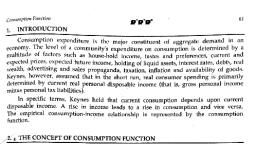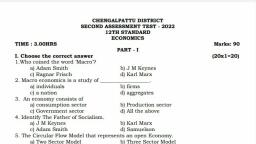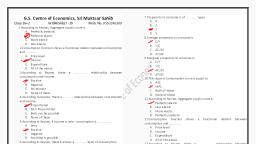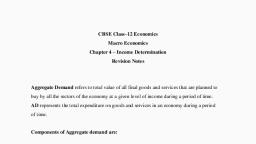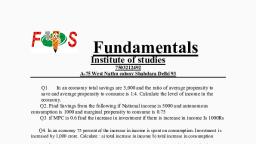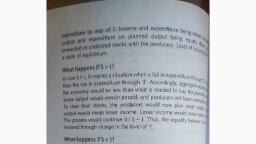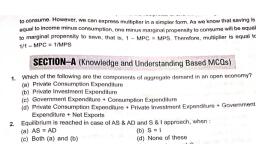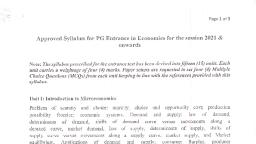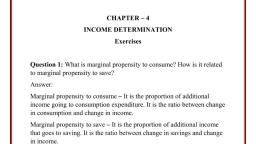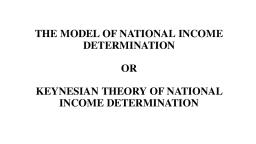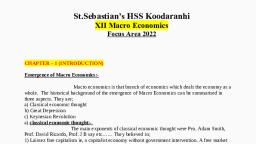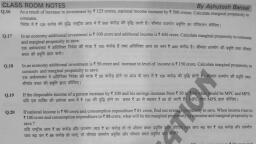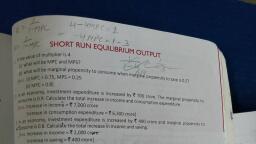Page 1 :
Unit - 3, , Determination of Income and Employment, , Question: - What do you mean by Aggregate Demand (AD)? What are its, , Components., , Answer: , Aggregate Demand is the Sum total of expenditure that the people plan to, incur (Spent) on the purchase of goods and services produced in the economy, during off on accounting year., , Aggregate demand can be measured with the help of , a. General price level., , b. Income level of people., , Here, AD will only be related with income level of people., , Component of aggregate demand (A.D) — There are four components of A.D., , a. Consumption expenditure (C). A.D =C +1+G+(X-M), b. Investment expenditure (I)., , c. Government expenditure (G)., , d. Net export (X — M)., , Consumption Expenditure (C) —, , It is the expenditure made by household on purchase of goods and services, during an accounting year., , This expenditure is directly influence by ‘Disposable Income’. i.e, Higher, Disposable income, Higher C and Vice — Versa., , Note , Disposable income is the income available to household for consumption and, , saving., , Investment Expenditure (I) —, , It is the expenditure made by private firm on purchase of capital goods., For simplicity investment expenditure (I) is assume to be autonomous. i.e,, , investment is no influence by income (Y)., , Government Expenditure (G) —, , It is the expenditure made by government (G) on consumer good and capital, good.
Page 2 :
e Consumption expenditure is done by government for public need. Like - Low, and Order, Education, Health, Transport defiance etc., e Investment expenditure is done by government for construction of rood,, railway, flyover etc., Net Export (X - M) e Itis the difference between export and import., e The magnitude of net export depends up ona. Rate of Exchange., b. Relative Price of Good., c. Exchange Duty., d. Trade Policy., Question: - Draw the schedule and graph of income e (Y), consumption, investment, or A.D?, , , , , , , , , , , , , , , , , , Answer: Income (Y) Consumption (C) Investment (I) A.D (C +1), , 0 40(C) 20 “60, 100 120 20 140, 200 200 (B = P) 20 220, 300 280 20 300, 400 360 20 380, 500 440 20 460, 600 520 20 540
Page 3 :
Y, AD=Ct+lAy, AD=C+I, , 60), , __ £40 |, ©} 20, , , , Y, , 0 100 200 300 400 500 600 income, , e Y Denote income., , e As the income increase, there is no change in investment, i.e, (I) curve should, be parallel to X axis. This is known as autonomous investment (Which does, not depend on income)., , e When Y = O there is a minimum level of consumption known as autonomous, consumption. It is denoted by., , e As the Y increase, C also increase. So, C curve is upward rising (Positively, Slop)., , e AD=C +1, where (I) is constant. So, AD curve will be parallel to C curve., , e The difference between AD curve and C curve is | curve., , Question: - What do you mean by aggregate (AS) supply? What are its components., Draw the diagram and schedule., Answer: e ASis the money value of final goods and services that all producer is planning, to supply in an economy during an accounting year., e ASis always equal to Y. Because —, a. The value of total output is distributed among the factors in the form of, rent, wages, interest, profit. These are called factor income and the sum, total of factor income become national income. Thus, AS = Y., , Components of AS
Page 4 :
e There are two components of AS., , a. Consumption., , b. Saving., Saving — It is the, , Saving schedule, , , , , , , , , , , , , , , , , , , , , , , , , , , , Income (Y) Consumption (C) Saving (S) (C +S) AS=Y, 0 40(C) - 40(-S) 0), , 100 120 - 20 100, 200 200 0 200, 300 280 20 300, 400 360 40 400, 500 440 60 500, 600 520 80 600, , AS=C+S, , Y=C+S, , S=Y-C, , =0-40, , dt, , , , , , Break - even, Level of Income, , Y
Page 5 :
¢ AScurve is known as 45° line of reference., e Saving curve is positively slope (Upward Rising) and start from negative, saving then become zero and finally become positive., e Relationship between Y, C, S a. When, Y <C, than S = negative., b. When, Y = C than S = O. (Break — even point)., c. When, Y > C than S = positive., , e Break — even level of income is the income where Y = C and S = O., , Question: - What is consumption function? What do you understand by APC and, MPC write its formula?, Answer: - Consumption Function —, , e tis the function relationship between consumption (C) and income (Y)., , * Itis denoted as C=C +MPC.Y., i. Where C = consumption expenditure., , ‘C = autonomous consumption., MPC = marginal propensity to consume., Y = national income., APC = Average propensity to consume., ii. It is the ratio between consumption (C) and income (Y)., , iii, APC= ¢ or, APC = 1 — APS., , iv. The range of APC is from 0 to ~., MPC = Marginal Propensity to Consume., i. It is the ratio of change in consumption and change in income., , i 22S ibid =, ii. MPC= AY or, MPC = 1 —- MPS., , iii, |The range of MPC is from 0 to 1., , Question: - What is saving function? What do you understand by APS and MPS? Write, its formula?, , Answer: - Saving Function

